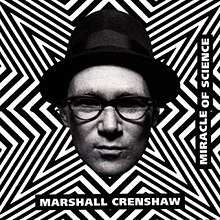| Miracle of Science | ||||
|---|---|---|---|---|
 | ||||
| Studio album by | ||||
| Released | 1996 | |||
| Studio | Alex the Great, Nashville, Tennessee | |||
| Genre | Rock | |||
| Length | 43:18 | |||
| Label | Razor & Tie | |||
| Producer | Marshall Crenshaw | |||
| Marshall Crenshaw chronology | ||||
| ||||
| Review scores | |
|---|---|
| Source | Rating |
| AllMusic | |
| Chicago Sun-Times | |
| Robert Christgau | |
| Rolling Stone | |
Miracle of Science is the seventh studio album by singer/songwriter Marshall Crenshaw, and his first studio effort for the indie imprint Razor & Tie.[5] Having left the major labels to increase his creative control,[6] Crenshaw produced the album and played most of the instruments.
Due to its status as Crenshaw's first indie album and first largely-self performed album, Miracle of Science has been singled by Crenshaw as a "case of circling back" to his pre-major label roots. He was largely spurred to record the album due to his faith in the song "What Do You Dream Of?": he explained, "I had 'What Do You Dream Of' as of 1992, a few years before the album. To some extent it was about needing to do an album in order to get that song out. You couldn't just do a single back then, at least I didn't think so."[7]
Crenshaw also revived "Starless Summer Sky" for the album, having co-written the song as "Starlit Summer Sky" in 1979. He recalled, "That was the first song that I ever co-wrote, or wrote, that I thought was great. It got passed over when I did my first album."[7] For its recording on Miracle of Science, he tweaked the song's title by changing "starlit" to "starless" to "give it a little bit of a dark atmosphere."[7] The album also features a cover of Grant Hart's "Twenty-Five Forty-One". Crenshaw noted, "I reached out to Grant around that time, when my record of the song was coming out. We were friendly after that, and I'd see him every once in a while, mostly when I had a gig in the Twin Cities."[7]
- ^ Miracle of Science at AllMusic
- ^ Sachs, Lloyd. "Spin Control". Chicago Sun-Times. Retrieved 5 September 2024.
- ^ Hoskyns, Barney. "Miracle of Science", Rolling Stone, September 19, 1996, p. 84.
- ^ Christgau, Robert. "Marshall Crenshaw". Robert Christgau. Retrieved 4 May 2011.
- ^ "Marshall Crenshaw".
- ^ ""I Had More Control": A Quick Interview With Marshall Crenshaw On The Reissue Of Miracle Of Science". A Pessimist Is Never Disappointed. Retrieved 24 October 2022.
- ^ a b c d Davidson, Eric (11 February 2020). "Marshall Crenshaw Is Having Another Field Day". PleaseKillMe. Retrieved 24 October 2022.